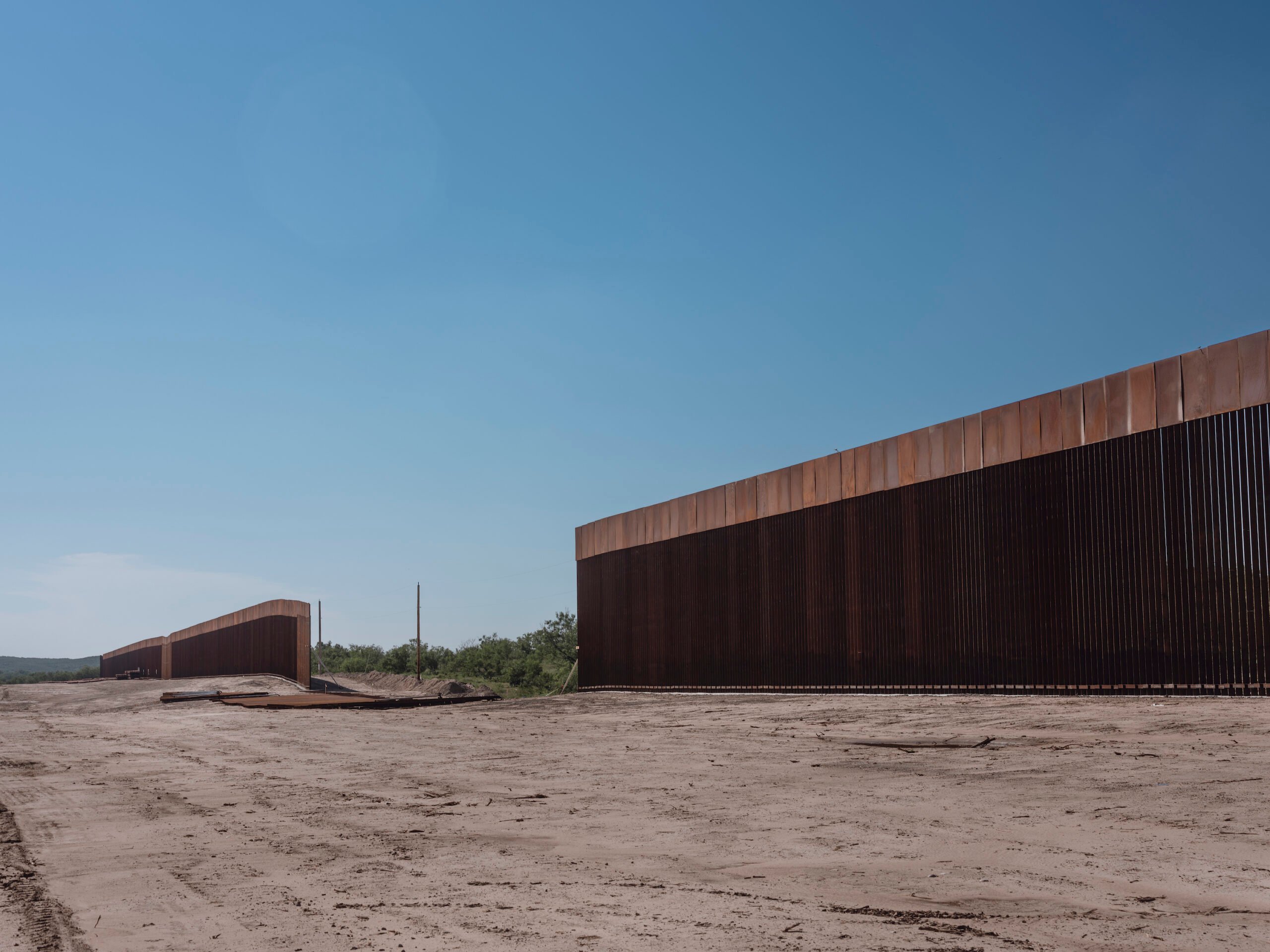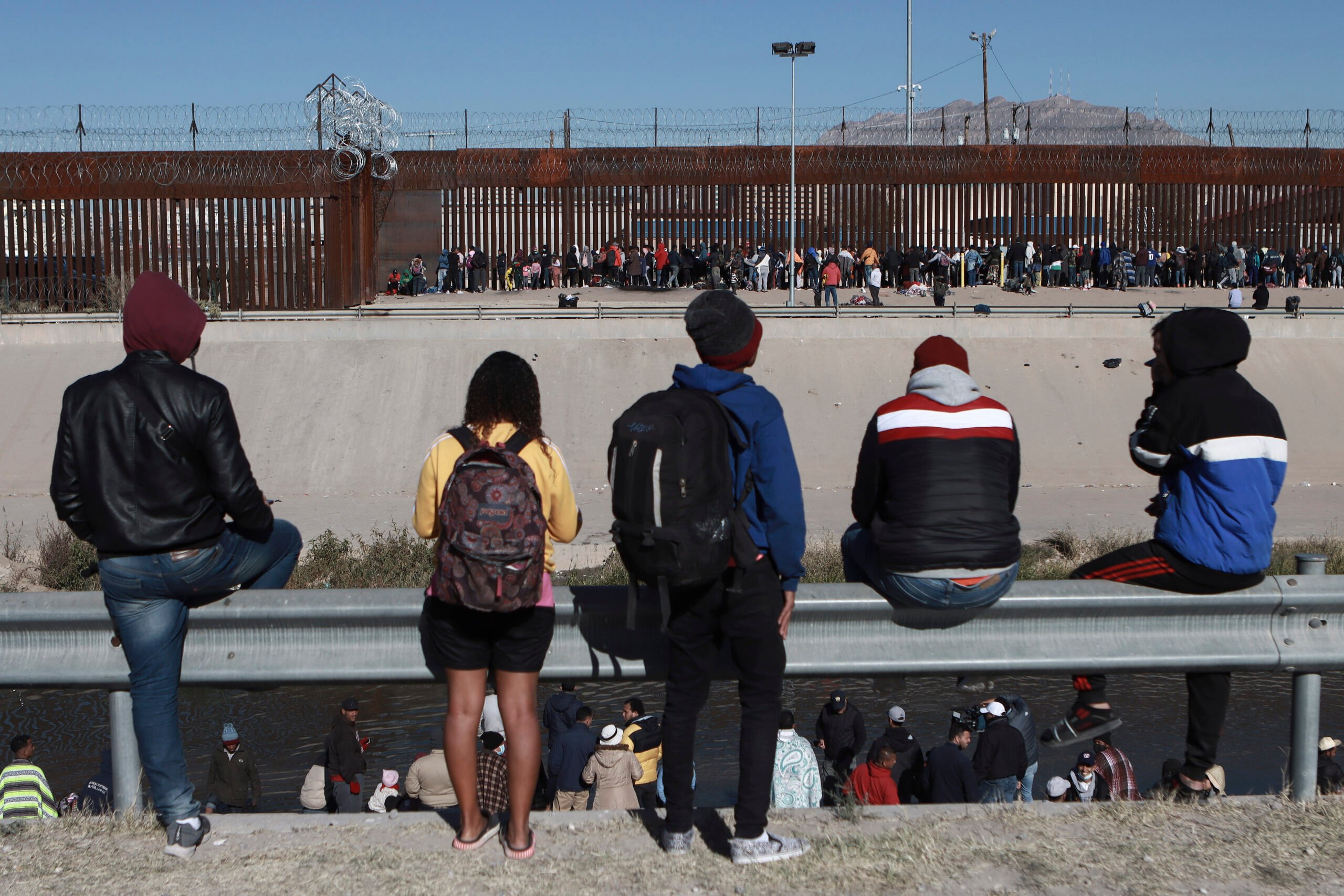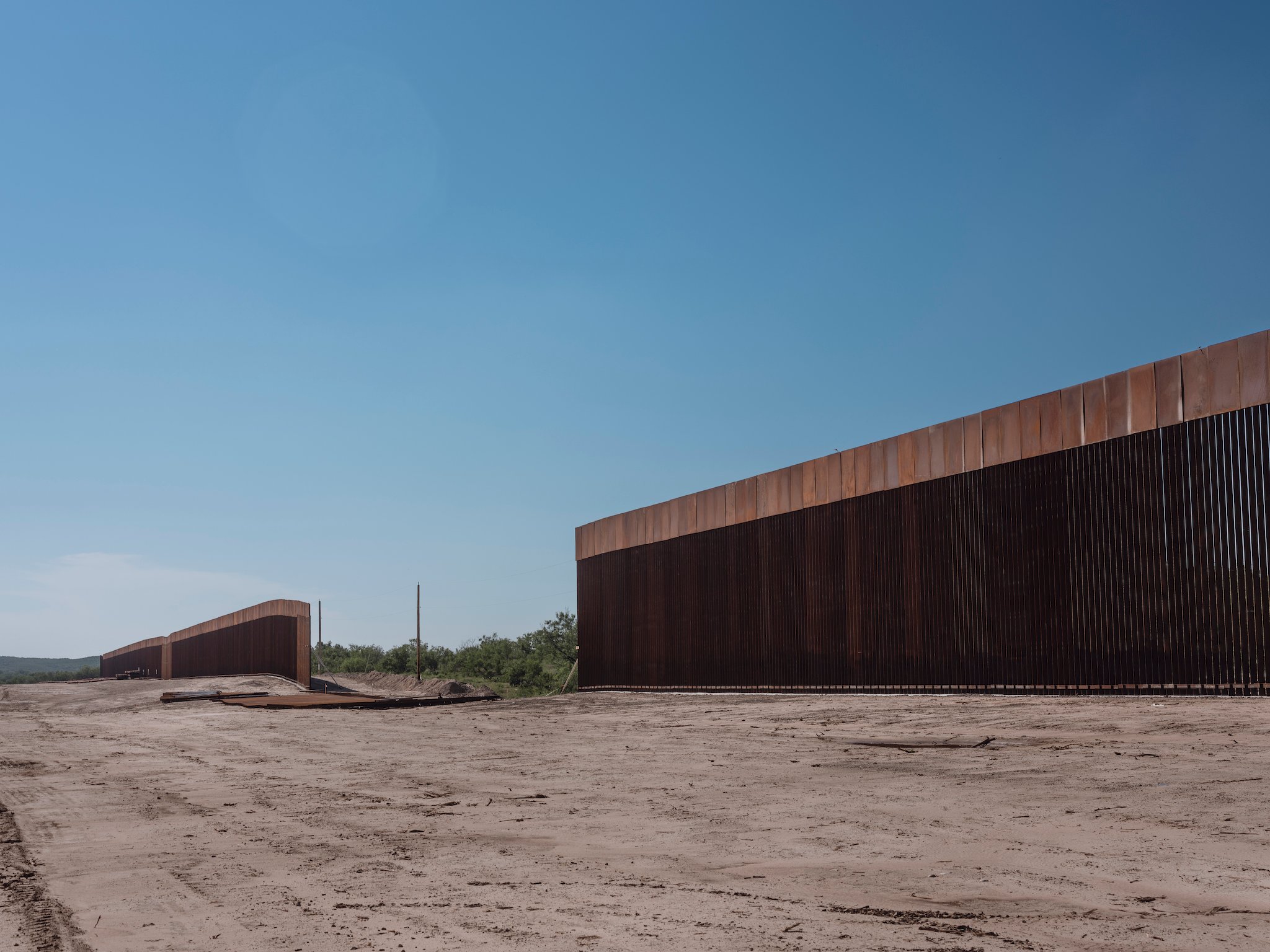Mary Ann Ortiz has deep roots on Vega Verde Road, which runs along the Rio Grande west of Del Rio. Ortiz was born and raised in this border town of 35,000 in Val Verde County, a couple of hours southwest of San Antonio, where her father owned a sizable ranch on the north side of the road. When he passed away, the ranch was sold off in various parcels. She bought her 16 acres of land in the 1990s and raised her family here.
Nowadays, the retired teacher raises goats in a pen in her backyard. Her sister lives just down the road, as do her three children. It’s nothing fancy, but it’s home. It’s quiet and peaceful. Or it was—until all the construction trucks started whizzing by nonstop. And there have certainly been effects of increased migration from across the border. It’s not uncommon to see small groups passing through, and some properties on the river side of the road have been vacated by owners after migrants started squatting in the houses, she said.
The increased rate of crossings from Mexico into this rural community was part of the reason she and the rest of her neighbors agreed to let the Texas Military Department build a 10-foot fence along their land next to the roadside, free of cost, in 2021. It’s helped stop, or at least slow, migrants crossing through her property—though the visibly patched chain-link barrier obviously isn’t perfect. Plus, the tall cyclone fencing topped with razor wire makes her feel like she’s living in a prison.
Ortiz takes pride in the fact that you can identify where her property line starts and ends, along with the rest of her family’s, because they were the only ones who opted not to have razor wire installed on top. But now she’s dealing with the threat of another, bigger fence. Like many of her neighbors, land agents first contacted Ortiz early last year to see if she’d be interested in allowing the State of Texas to build a border wall along the back of her land. As it turned out, her home was right in the middle of a nearly 7-mile stretch of 30-foot steel wall that the state was planning to build on orders from Republican Governor Greg Abbott.
From the start, Ortiz was a firm “no.” But the land agent, who worked for a private company contracted by the state to acquire border properties, “kept coming back and coming back,” Ortiz recalls, giving an initial quote for payment, then coming back later with higher offers. “So he was kind of lowballing us at the very beginning,” she said. “I kept telling him, ‘You’re wasting your time. … I love my house. I love my ranch, no.’”
Ortiz’s predicament was the result of a highly politicized, multi-billion-dollar border security scheme rolled out by Abbott in 2021. Key to the governor’s border gambit, dubbed “Operation Lone Star,” was a promise familiar to anyone with a pulse during the administration of former President Donald Trump: to build a great wall dividing Texas from Mexico. At first, this may have seemed like so much political bluster. Presidents from George W. Bush to Trump had struggled to build a wall along Texas’ privately owned, nigh untamable, and riverine border—and unlike them, Abbott didn’t even have the power of eminent domain to wrench land from residents.
Nevertheless, Abbott’s scheme is slowly and inefficiently becoming what could be one of the largest and most expensive public infrastructure projects in state history. At his direction, the state government has identified about 800 miles of border supposedly in need of a barrier; at the state’s current pace, that would put taxpayers on the hook for nearly $20 billion over 30 years. The Legislature has already shoveled nearly $1 billion to the governor for a first installment of roughly 40 miles, with close to another billion dollars on the way for the next phase. Abbott’s wall is primed to become a permanent strain on taxpayers’ wallets, a direct threat to border communities, wildlife, and landowners who fear they will be railroaded by the state, and a new source of cronyism as the state wheels and deals with political patrons to advance the governor’s pet project.
After ramping up slowly and quietly in the background of the governor’s broader border offensive, Abbott’s wall is now quickly becoming reality. For Ortiz and others who live along Vega Verde Road, that reality has become an unwelcome incursion.
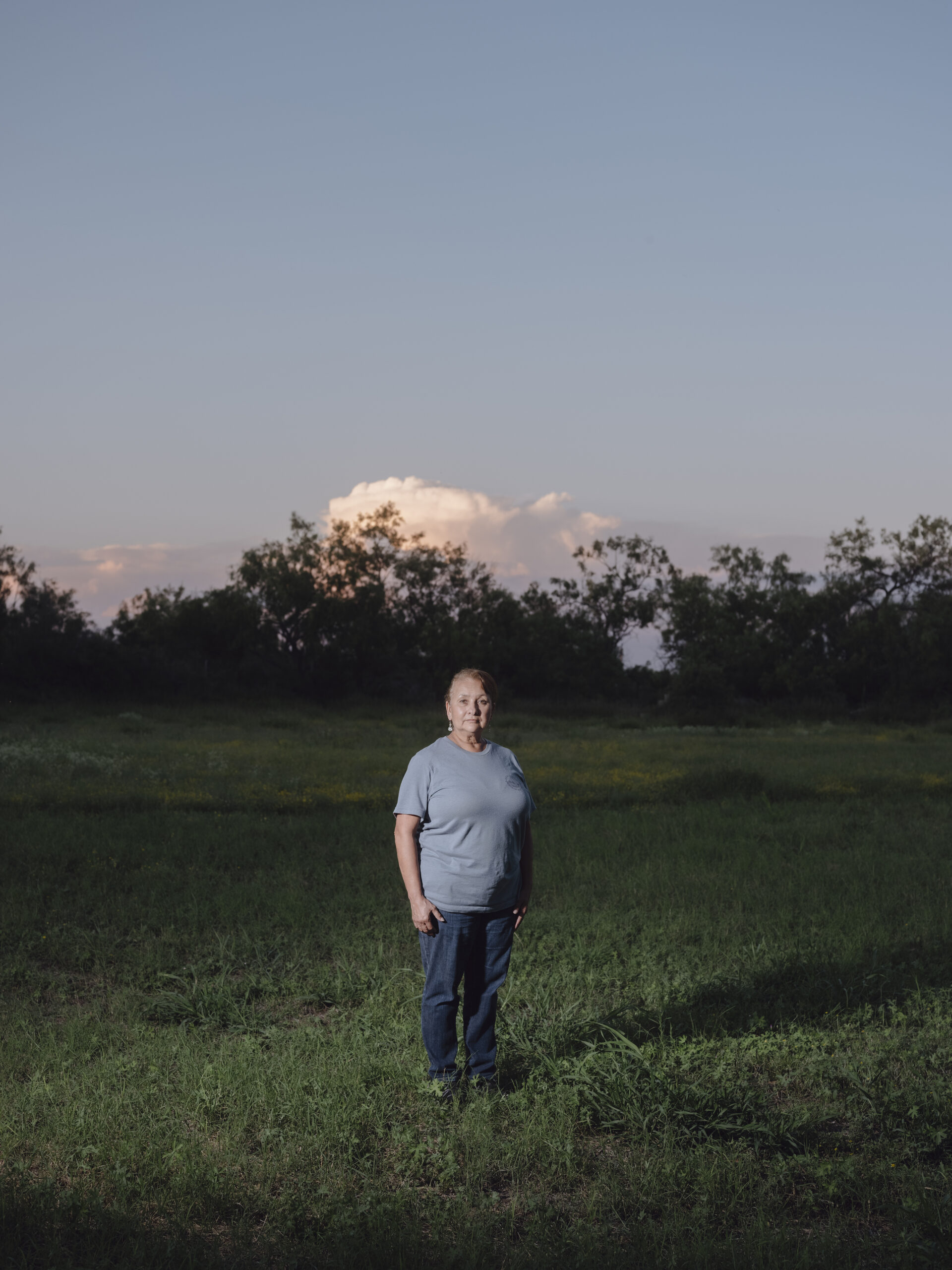
Whatever the state was offering, Ortiz knew it wouldn’t account for the impact of a hulking wall on the value of her land and house. “This,” she said, pointing to her home, “is not going to be worth what it’s supposed to be worth. … Who’s going to want to buy a house with a big border wall saying, ‘Okay, you belong to Mexico; you belong to [Ciudad] Acuña’?”
But the state acquired the rights to build its wall on land owned by many of her neighbors. Since construction began this spring, the wall has grown closer to both sides of her property, and Ortiz fears it will just funnel traffic from across the border through her home. She and others on Vega Verde worry that, eventually, they may be forced to take whatever the state offers.
Ortiz’s son Raul Gaona, who moved with his family four years ago into a house just down the road, is in an even worse position. The state wants to build right through his property, too, but the wall would end up coming within a stone’s throw from the front door of his home. He rejected their first offer, and when they came back offering twice as much, he declined again: “$18,000 won’t last me too long, and I’ll have that fence here the rest of my life.”
Gaona cherishes the solitude of sitting on his front porch with no one around. If he had an ugly wall looming over him, he said he would probably move away. “I’m going to wait it out, see what happens,” he said. “We just got here. … I really don’t want to just up and leave already.”
Two years ago, Abbott came to Del Rio for a border security town hall at the local civic center, where he trumpeted the rollout of his nascent Operation Lone Star. Gearing up for a third-term reelection bid, Abbott was facing increasingly heated threats of primary challenges from his right flank, and he was using this newfangled operation, the latest in a long line of theatrical border security surges in Texas, as a way to burnish his immigration hawk credentials.
His town hall speech climaxed with an announcement that he would soon begin construction of a border wall in Texas, picking up Trump’s wall-building mantle, which had been shirked by President Joe Biden. The pronouncement drew rapturous applause and cheers from the crowd, which Abbott paused to soak in for nearly 20 seconds.
“It’s a Third World country where these farmers and ranchers are living with their lives on the line every single day,” Abbott said, in an interview days later, of the need for a wall in places like Del Rio. “Somebody has to step up for these people. And that’s the governor of Texas.”
Some Texas GOP leaders like ex-Governor Rick Perry and Senator John Cornyn, possessed of at least a passing familiarity with the state’s border, have been skeptical of physical border walls. But Trump completely shifted the Overton window such that building the wall eclipsed everything else, including concerns about the feds infringing on private property rights and the exorbitant cost to taxpayers.
“Governor Abbott had to build this wall. There was no choice politically. This was the direction the party was going,” said Brandon Rottinghaus, a University of Houston political science professor. “He had to follow along or be left behind.”
The Trump administration targeted nearly 750 miles of U.S.-Mexico border for wall construction at an average cost of about $20 million per mile—a rate five times higher than the cost of fencing built by prior administrations. Ultimately, Trump completed only about 400 miles of wall, much of that in the form of replacing existing smaller barriers in Southwestern states where the borderlands were already federally owned. Even with federal eminent domain powers, Trump struggled to wrench land away from Texas fronterizos—whose land is often passed down by family through several generations with tangled webs of ownership records—building only 50 miles in Texas, about 20 of those miles in the Rio Grande Valley.
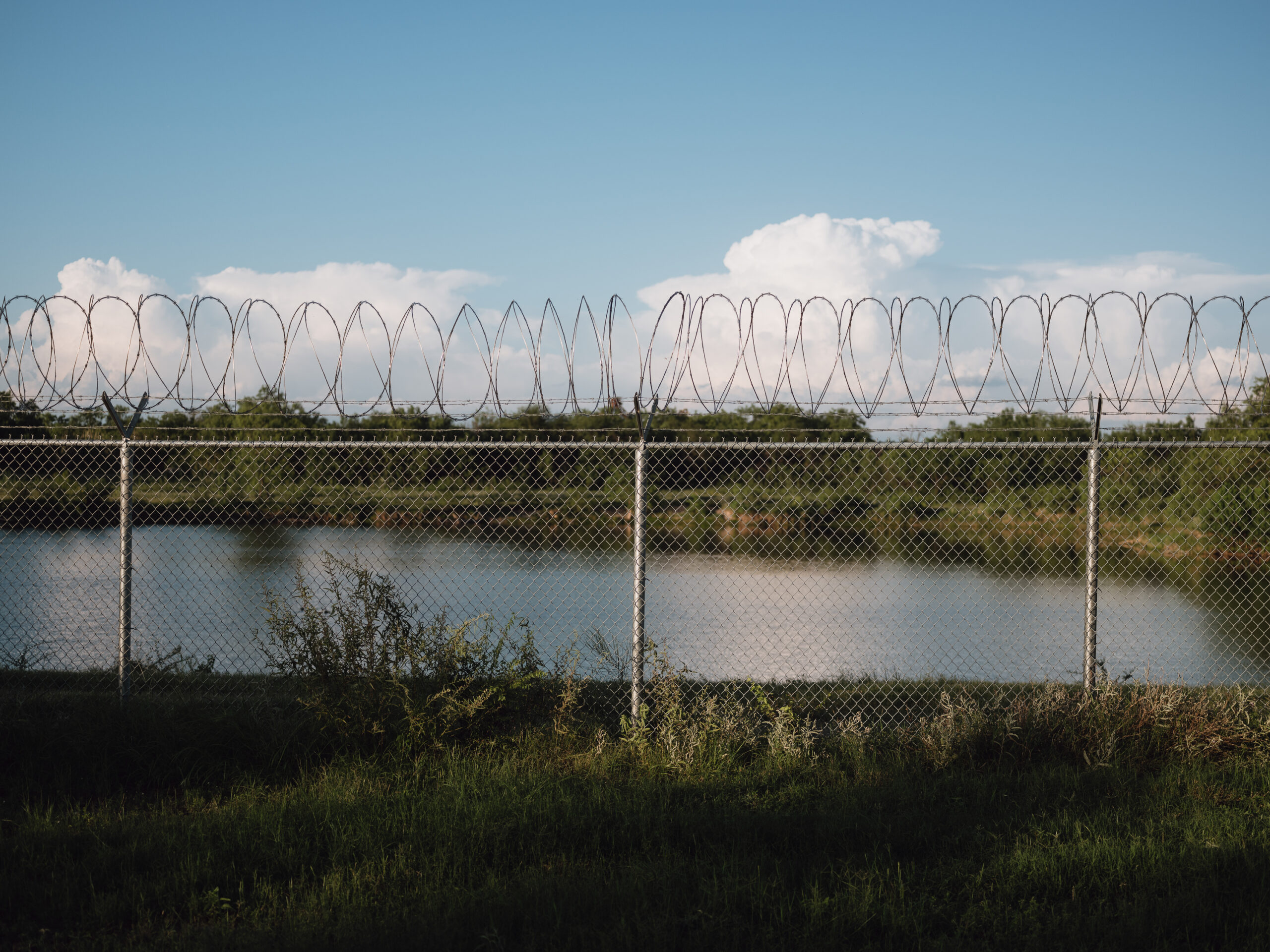
When Biden took office in early 2021, he ground almost all wall construction to a halt, suspending billions in awarded contracts and throwing condemnation lawsuits into limbo. The State of Texas promptly sued the feds, claiming that Biden was legally mandated to continue construction, in a pending case. Since Biden’s ascension to the White House, “The border wall has become a living symbol of the Republican Party’s desire to put a fork in the eye of the federal government and to use that as political leverage in Texas,” Rottinghaus said.
A week after his Del Rio summit, Abbott, flanked by a coterie of top Republican lawmakers in Austin, issued a directive ordering the Texas Facilities Commission (TFC)—a small agency in charge of constructing and maintaining state government offices—to direct his massive, politically driven wall-building project. And Abbott signed a letter to Biden demanding that the president return any private property seized by the feds to landowners so the state could negotiate with those landowners for its own wall.
At Abbott’s side, Lieutenant Governor Dan Patrick humbly declared that the governor’s directive was more consequential than any other action taken by a governor in modern history. “This document will go down as one of the most important documents in the history of Texas. Because it’s reclaiming our land, our border, our country, our state, for the people of Texas and America,” he crowed. “We are being invaded.”
Abbott’s critics met the rollout of his border wall project with outrage over the use of state money to continue a federal project, along with skepticism about whether this was all just a big campaign stunt. But, regardless of the original motivation, Abbott seems to have committed to the bit—and he’s validating virtually all his detractors’ concerns along the way.
Since its launch, the state has provided little in the way of public information or transparency about the details of its border wall plans. TFC has refused to provide or confirm basic details about the project, citing concerns about homeland security and terrorism. The agency has also declined the Texas Observer’s requests to interview the TFC executive director or commissioners.
Over the past several months, the Observer has filed numerous public information requests and scoured public contract documents, state expenditure data, and county land records to track where the wall is headed, how taxpayer money is being spent, and to get an inside look at how the state government has navigated its entry into the perilous business of wall-building.
“Governor Abbott had to build this wall. There was no choice politically.”
Abbott’s wall-building scheme, like its federal predecessor, has so far proven itself to be a slow-moving, billion-plus-dollar boondoggle that has produced very little completed wall and plenty of logistical quagmires, delays, and soaring costs, while sparking resistance and resentment among many landowners and local leaders who find themselves in the project’s path.
Local officials have often been kept in the dark about plans developed and approved hundreds of miles away in Austin to build wall in their communities. Meanwhile, the GOP-controlled Legislature eagerly rubber-stamped $1 billion for the governor’s wall in 2021. This session, a bill by GOP state Senator Brandon Creighton that would have given TFC eminent domain powers to construct its wall—citing the need to build more quickly—died without a floor vote. But, with hardly any public oversight and debate, lawmakers approved a budget that gives the governor roughly another billion dollars for the wall.
Driving along the peaks of a rolling caliche road in western Starr County in mid-May, stretches of border fencing peek out through the rolling green chaparral and scrubland, cutting through the landscape for thousands of feet like a rust-colored wound. An orchestra of rare birds chirping competes with the faint din of heavy machinery down in a valley—the beeping and grinding and whirring of bulldozers and concrete trucks.
A few weeks earlier, botanists and plant enthusiasts from around the Rio Grande Valley received an emergency bat signal and flocked to a private ranch that runs along the river in remote western Starr County. The pristine land features a largely undisturbed habitat home to a diverse array of rare plant and animal species. For years, it’s been a destination for birders and naturalists to visit with permission from the owner.
In January, though, the landowner—a family who asked that their name not be used in this story—had signed an easement granting the State of Texas permission to build a border wall through the property, county land records show. Now, construction crews were beginning to raze a path over 2 miles long through the ranch, destroying any habitat in the way. The plant-lovers’ plan was to rescue as many specimens as possible and transplant them to a new home on a private property a few miles away.
One of those who came to help was an amateur botanist who goes by Joey Santore. He produces a popular YouTube channel called “Crime Pays But Botany Doesn’t,” featuring his self-described “low-brow, crass approach to plant ecology as muttered by a misanthropic Chicago Italian.” In early April, he ran an episode that documented the devastating impact of Abbott’s wall on this land as volunteers scrambled in 100-degree fahrenheit heat to save as much as they could.
His camera panned across a portion of land that had just been bulldozed as he asked, “How much cool stuff was just destroyed this morning?” He showed a bulldozer in action, stirring up a massive plume of dust on what had become a barren swath of land. Aerial drone footage showed the immense footprint of the coming wall. All this, he mused, for a stupid political stunt: “This is just Abbott basically just trying to flex his muscle and put on some showmanship.”
Stakes in the ground marked what would soon be cleared. “Everything that way is getting smushed,” he said. He pointed to a giant clump of coryphantha macromeris—nipple beehive cactus—to yucca constricta and hechtia, to dahlia hedgehog, fish-hook cacti, and peyote: rare and native plants, highly resilient species that thrive in this arid, rocky habitat with strong, nutrient-dense tuberous roots. Santore noticed a bed of large fossils that he said was from the Eocene Epoch when, over 30 million years ago, this land was at the bottom of a shallow ocean. “This is fuckin’ morbid man. Texas just does not give a fuck.”
A biologist in the video told Santore that volunteers had recently found a handful of prostrate milkweed plants around the property, including one in the impact zone of construction, which they were able to save. Just weeks earlier, in late February, the U.S. Fish and Wildlife Service had officially listed the rare plant—which exists in just a few populations in South Texas and northern Mexico—as an endangered species. When the agency had initially announced its proposal a year earlier, Texas Attorney General Ken Paxton promptly filed a 12-page letter complaining that the Biden administration was restricting the state’s ability to implement border security measures—“including but not limited to construction of a border barrier.”
The governor’s office also chided Biden for kowtowing to woke wildlife. “Instead of stepping up to protect innocent lives from human traffickers and stopping the influx of deadly drugs like fentanyl from coming across our border, President Biden has instead chosen to focus on protecting plants,” an Abbott spokesperson told the Texas Tribune last February.
Even with the federal designation, it’s not clear that the presence of endangered prostate milkweed would halt construction of the state wall in this part of Starr County, since the Endangered Species Act provides fewer protections for vulnerable plants on state and private land than on federal property. Records show that TFC and its project contractors knew there was a possible presence of prostrate milkweed and Zapata bladderpod, another endangered plant, on the ranch that could be impacted by the wall construction; it’s not clear what, if any, measures were taken. TFC said in a statement that its program manager, the Michael Baker & Huitt-Zollars Joint Venture, “is responsible for ensuring compliance with environmental and regulatory requirements from a program perspective.”
Starr County had been among Trump’s primary targets for his wall, with the administration essentially planning to wall off the entire county. The feds seized many riverside properties but managed to build almost nothing before Trump left office. The ranch featured in Santore’s YouTube video was spared condemnation during Trump’s term. Then the state came knocking with its plans to build 7 miles along a stretch of land west of the border town of Roma.
The state awarded the contract for the ranch in Santore’s video to a company called BFBC, which was among the top wall builders for Trump. The firm is getting $47 million to build the 1.75 mile segment, a rate of nearly $27 million per mile. Timothy Barnard, the founder and chairman of BFBC’s parent company, is an active GOP donor. After BFBC got its state contract last September, he cut a $5,000 check to Abbott’s campaign—his first donation to a state politician in Texas. The company did not respond to a request for comment.
“This is fuckin’ morbid man. Texas just does not give a fuck.”
Other landowners in the area, such as the Valley Land Fund, a conservation group that owns a small bird preserve on the banks of the river in Saliñeno—a popular spot for birders visiting from around the country—are standing firm against the state. “We have just chosen to take a stand to not allow the state to access our land,” said Debralee Rodriguez, executive director of the group. Building a wall through their property, which is just 2.6 acres and under 300 feet wide, would almost certainly force the reserve to close: “If you did that to our small land, you’d wipe out all our vegetation.”
Despite the Fund’s resistance, the state appears to be going ahead with plans to build right next to its northern property line, on a piece of land owned by a local water supply company, according to county property records. If that happens, the bird sanctuary would be surrounded on either side.
The state’s proposed wall route in Starr includes dozens of land parcels, many of which were seized or targeted by the feds under Trump. Courts have since returned much of that property, but Texas is having a hard time persuading these landowners to voluntarily sign over land rights.
Abbott and TFC have publicly said that most people are willing to accept the wall on their land and that “hard no’s” are few and far between. But in contract documents from February, the state’s program manager painted a less rosy picture: Along the first 45 miles targeted by the state, only 25 percent of landowners were participating.
In the nearly two years after the wall project was launched, very little new fencing was completed. By the end of 2022, the first segment of wall along 1.7 miles of farmland, owned by the state’s General Land Office in rural Starr County, was only just getting completed—roughly five months behind schedule and at a cost of about $35 million, contract records show. And that was supposed to be the easy part.
Texas has awarded contracts worth nearly $850 million to build 40 miles in various segments from Brownsville and Los Indios, near the Gulf, upriver to Starr County, through big ranches and tiny towns in Webb County, to Del Rio.
Millions of dollars have been spent on a small army of land agents, appraisers, and title agents who’ve swarmed across South Texas working to convince landowners to sign over their land for Abbott’s wall. Yet TFC has obtained just a fraction of the land needed to complete its first phase of construction. As of May, the agency had closed deals for about 15 miles of property, with 25 miles still in the negotiation process, records show. Only 3.48 miles of wall had actually been completed—out of the over 700 miles that Abbott wants in total.
“The planning here is very piecemeal and doesn’t appear to have a systematic goal, except to just show the flag and pretend that something approximating the Trump effort is still continuing,” said Charles Tiefer, a professor at the University of Baltimore School of Law who specializes in government contracting. “The Trump effort had the resources of the federal government behind it. Even that wasn’t enough.”
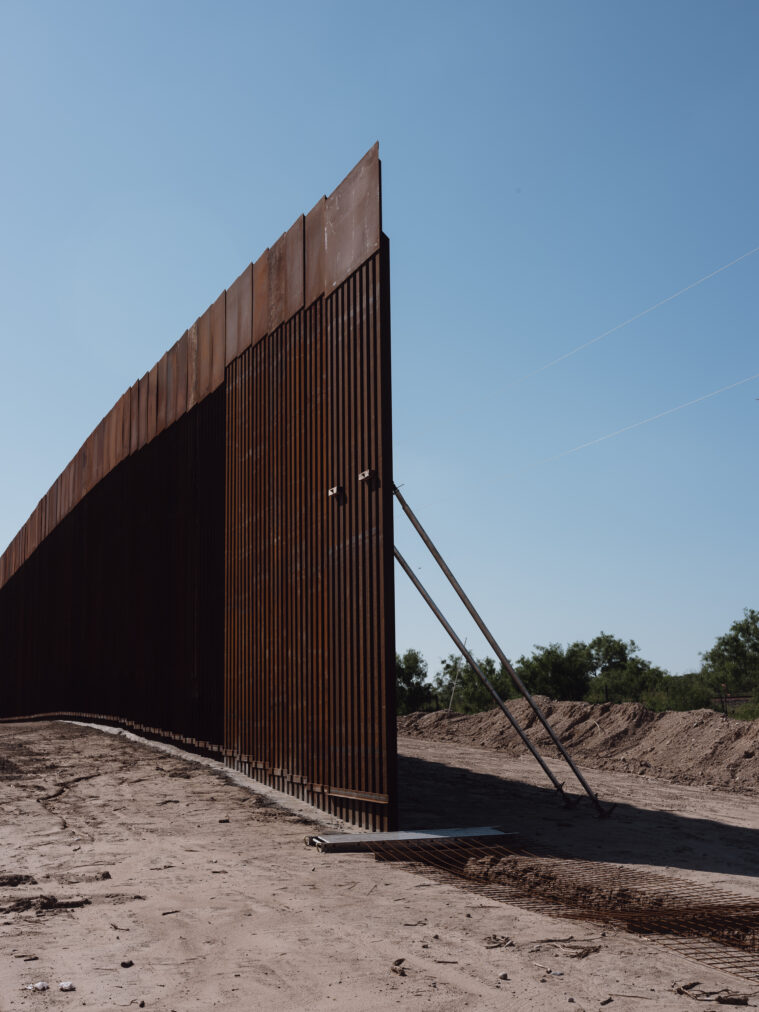
The agency that Abbott has put in charge of all this, the Texas Facilities Commission, is run by Michael Novak, a tall, silver-haired former construction executive from San Antonio who once ran a failed bid as a Chamber of Commerce conservative against incumbent state Senator Donna Campbell. He served for several years as a commissioner at TFC until he was tapped to become executive director in 2018.
Novak described his agency’s assignment as needing to essentially replicate the Army Corps of Engineers, the federal government’s civil engineering outfit that designed and directed the Trump wall effort. TFC has done this by effectively outsourcing the entire operation to a pair of private contractors: Broaddus & Associates, which advises the state agency, and the Michael Baker & Huitt-Zollars Joint Venture, the project manager in charge of construction.
“Sending the TFC out to build a wall along the length of the U.S.-Mexico border is like calling up Angie’s List to get someone to build a fortress,” Tiefer said.
Abbott specifically ordered the wall to be built to the exact same specifications as Trump’s, so the design phase may have been a light lift. But his early promises that landowners would volunteer property and that money would flow in from red-blooded Americans nationwide have fallen flat. A crowdfunding effort Abbott launched in 2021 pulled in a little over $50 million, with 98 percent coming from a hermetic billionaire heir in Wyoming.
Baker & Huitt’s initial contract, for $10.3 million, has since tripled in cost through a series of amendments as the project expanded and more resources were pumped into the state’s land acquisition campaign. By mid-November of 2022, the firm had exhausted its budget, meant to last through March, due to protracted land acquisition challenges, requiring a contract amendment for another $2.5 million just to keep going. “It is obvious that a different model for negotiations will need to be employed to curtail endless negotiations with landowners on these projects,” the company wrote in its amended contract proposal. A few months later, TFC extended Baker & Huitt’s contract through the end of 2024.
Abbott has acknowledged his wall’s molassal pace, while claiming things are improving. “One thing that has slowed our process a little bit is getting those rights to build the wall,” he said in January at a press conference in the tiny border community of Los Indios, where he celebrated the start of a less-than-mile stretch of wall and announced a new “border czar.” But the governor’s bullish on his project’s future: “With the work of the Facilities Commission, we have accelerated that process of acquiring the land rights.” In a TV interview later that month, Abbott predicted that in 2023, “We may wind up adding more border wall than President Trump was able to add in his entire presidency.”
More wall means more money for the lucky few contractors that were selected, through an open bid process, to build the first 40 miles of wall: Posillico Civil, Southwest Valley Constructors, BFBC, Fisher Sand & Gravel, and SLSCO. All of these firms had collectively received billions in federal contract awards to build the Trump wall, and one of them—Fisher—built a private wall in Hidalgo County that was originally connected to a fraudulent crowdfunding scheme run by now-convicted Trump allies. That wall is now in danger of collapsing into the Rio Grande.
By spring, four of these contractors had finally begun construction on six different sites totalling close to 15 miles. “We feel the program has reached a tipping point and we are gaining significant momentum,” Richard Cellon, one of TFC’s project consultants, said at a March meeting. But the effort was still well behind schedule. TFC had initially estimated that the five construction projects would be completed by mid-2024, records show, but ahead of this year’s legislative session,TFC had pushed its estimate back to the fall of 2025—four years after the border wall funds were approved.
As sine die approached in late May, Texas had completed less than four miles of border wall. The Facilities Commission had paid out about $150 million in total for the wall, including $90 million to its builders and over $40 million to Gibraltar Fabrication for 13 miles worth of steel bollard panels—which the state claims to have bought at a steep discount because of the feds halting wall construction. TFC had also paid about $3.75 million to acquire land rights from dozens of property owners.
At least one of these land deals has also raised the specter of possible cronyism. In February, the state struck a deal to acquire the rights to build five miles of wall through Faith Ranch in the vast, unpopulated terrain of far western Webb County. The ranch is owned by Houston oil and ranching heir Stuart Stedman, a longtime ally of the governor who has given his campaign over $1 million since 2015. The state paid him $1.5 million in the deal—effectively funneling public dollars to a major Abbott donor to boost the governor’s pet project. TFC then awarded the construction contract to build the wall through the ranch to none other than Fisher Sand & Gravel.
It will cost Texas taxpayers $120 million for Fisher to build the 5-mile-long wall through the ranch of the governor’s buddy, about $24 million per mile, which will require building an access road through the ranch to the nearest county road. Stedman’s agreement also stipulates that the wall will include several gates, openings for irrigation and drainage pipes, and construction of a new cattle fence—accommodations that not all landowners are receiving.
TFC told the Observer that it couldn’t comment on negotiations or other specifics about the Faith Ranch project due to “security concerns and protecting procurement integrity,” though the agency did say the governor was not involved. Stedman did not respond to requests for comment. The governor’s office did not respond to requests for comment about this and other matters for this story.
Back along Vega Verde Road, on a late Tuesday morning in early May, one landowner looked regretfully across a swath of razed land along the back end of his small ranch as construction crews crossed into the western edge of his property and began installing rusty reddish steel bollard panels. If he’d known what he did now, he would have never signed up for this.
Land agents from a company called Universal Field Services, which is contracted to acquire land for the state, first contacted the retired rancher—who did not want his name used due to privacy and safety concerns—about a year ago with an offer to acquire the rights to build a border wall through his property.
While the state was prohibited from using eminent domain to seize land for its wall, the landowner said the landmen implied he would be wise to sell now lest that change. “Whether you like it or not, it was going to be built,” he said, summarizing their pitch. So he bargained their initial offer up to $25,000 and signed a contract granting the state a permanent 50-foot-wide easement to build its wall and a patrol road along his back property line, a decision he now wishes he could take back.
A former mechanic at Laughlin Air Force Base near Del Rio, he bought his 40-acre piece of land nearly 20 years ago for his retirement. The ranchette wasn’t a moneymaker, but over the years he’s been able to raise some cattle, goats, pigs, and horses. The payment from the state last year covered a substantial amount of what he originally paid for the property. He figured a big wall along the edge of his ranch, which abuts a railroad track, wouldn’t be a big deal.
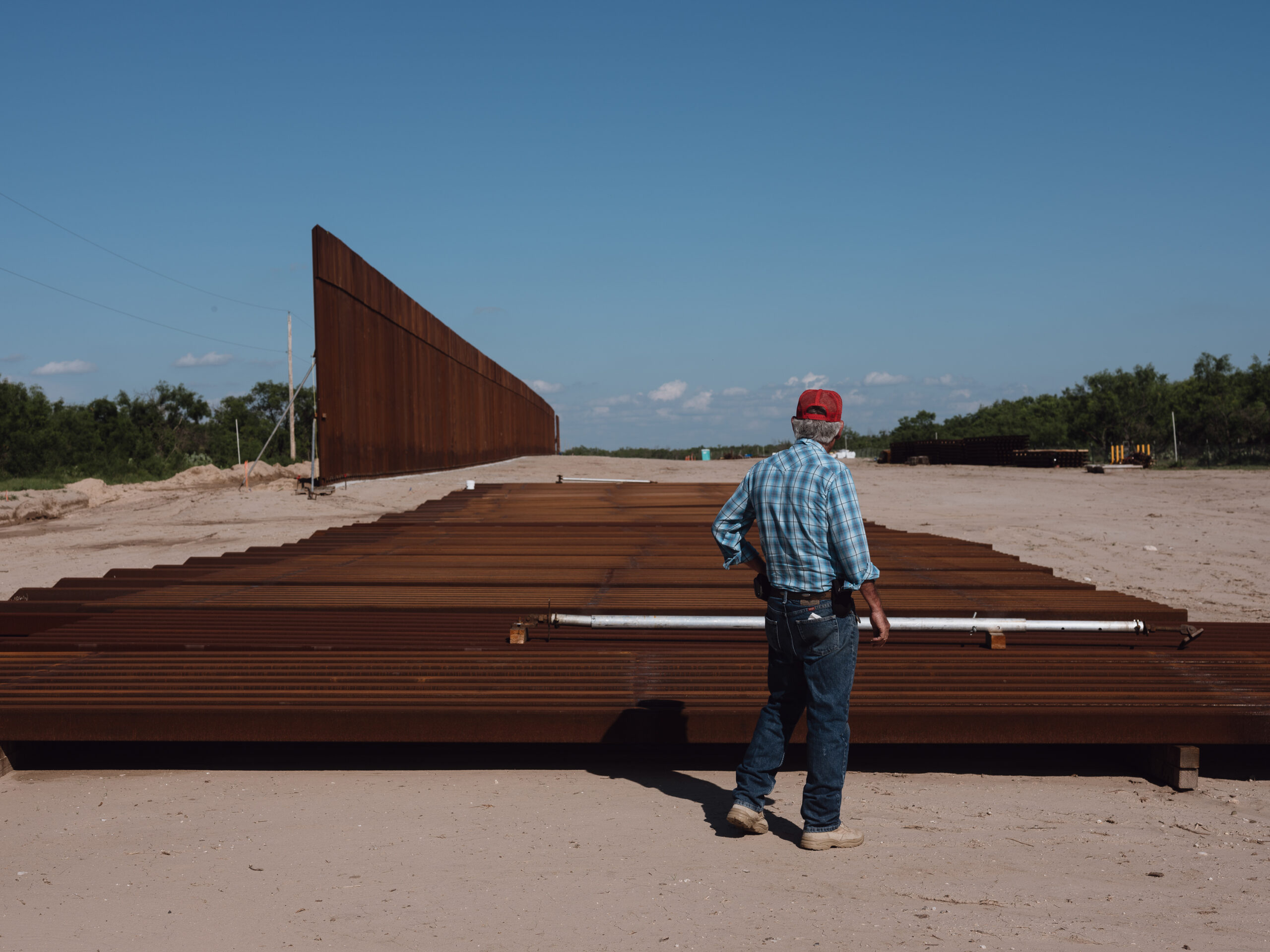
But once construction crews began clearing the back portion of his land in April, the landowner realized the wall wasn’t going to be built along his property line as agreed. Instead, it would run 30 feet inside that line—lopping off the back of his ranch. Apparently, the electric company that runs its power lines along the railway had recently told the state it had to realign its wall route.
The state’s land agents, he said, didn’t inform him of the change until he confronted them, and he spent weeks trying to get the state to compensate him for the additional land and comply with other terms of his original agreement—all while construction continued through his property.
The state ultimately offered to pay him $15,000 more, he said, but no final deal had been reached as of mid-June—in part because he said the state reneged on a promise to install an access gate.
“Due to security and privacy concerns, specific project details are not being released at this time,” a TFC spokesperson said in a statement. The agency, and its team of contractors, “works diligently to address all construction concerns with stakeholders.”
As he watched the wall cut through his ranch, one steel panel after another, the Del Rio landowner felt that even if he got the extra money, it wouldn’t be worth it. The impact of wall construction was far beyond what he’d imagined: The crews are using his own soil to level the path for the wall and have reshaped the land in a way that will funnel all the rainwater and runoff from neighboring properties into his property. “They’re pretty much using the rest of my property for their project,” he said. After a recent heavy rain, he said he found a strange white fluid in a pond on his land that he believes is runoff from the construction.
Looking back, this landowner feels like he got burned by the agents who were sent to acquire his land on behalf of the state. “Don’t trust them,” he said. “They already did me wrong.”
